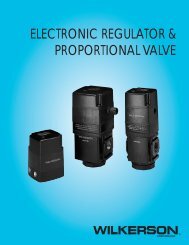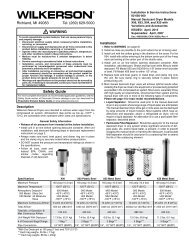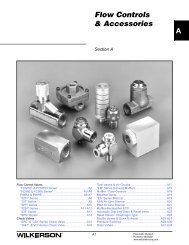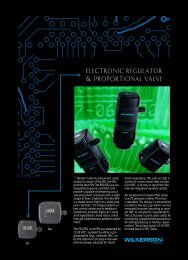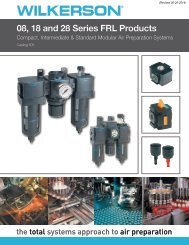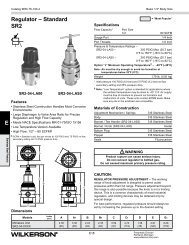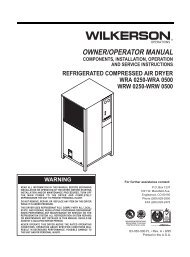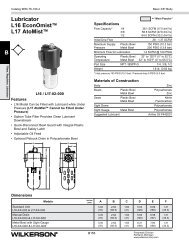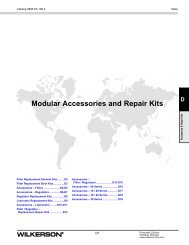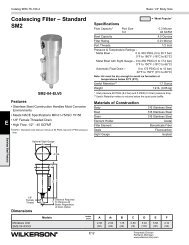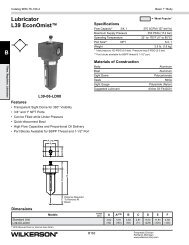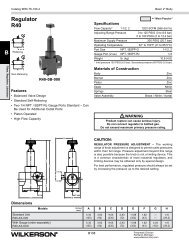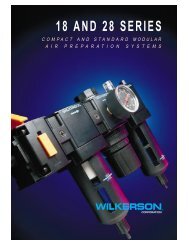- Page 1 and 2: Compressed Air Treatment Catalog 9E
- Page 3 and 4: DISTRIBUTION NETWORK Wilkerson manu
- Page 5 and 6: Compressed Air Systems Filters, Reg
- Page 7 and 8: Catalog 9EM-TK-190-3 Stainless Stee
- Page 9 and 10: Catalog 9EM-TK-190-3 Basic Unit A F
- Page 11 and 12: Catalog 9EM-TK-190-3 Basic Unit Ser
- Page 13 and 14: Catalog 9EM-TK-190-3 also contribut
- Page 15 and 16: Catalog 9EM-TK-190-3 Particulate Fi
- Page 17 and 18: Catalog 9EM-TK-190-3 Coalescing Ele
- Page 19 and 20: Catalog 9EM-TK-190-3 Type B Filter
- Page 21 and 22: Catalog 9EM-TK-190-3 Filter Types A
- Page 23 and 24: Catalog 9EM-TK-190-3 Critical Appli
- Page 25 and 26: Catalog 9EM-TK-190-3 Regulators Gen
- Page 27 and 28: Catalog 9EM-TK-190-3 Lubricators Ec
- Page 29 and 30: Catalog 9EM-TK-190-3 18 / 28 Series
- Page 31: Catalog 9EM-TK-190-3 AIR PREPARATIO
- Page 35 and 36: Catalog 9EM-TK-190-3 Particulate Fi
- Page 37 and 38: Catalog 9EM-TK-190-3 Particulate Fi
- Page 39 and 40: Catalog 9EM-TK-190-3 Replacement El
- Page 41 and 42: Catalog 9EM-TK-190-3 Replacement Bo
- Page 43 and 44: Catalog 9EM-TK-190-3 Replacement Bo
- Page 45 and 46: Catalog 9EM-TK-190-3 Replacement Bo
- Page 47 and 48: Catalog 9EM-TK-190-3 Replacement Bo
- Page 49 and 50: Catalog 9EM-TK-190-3 Replacement Bo
- Page 51 and 52: Catalog 9EM-TK-190-3 Replacement Bo
- Page 53 and 54: Catalog 9EM-TK-190-3 Replacement Bo
- Page 55 and 56: Catalog 9EM-TK-190-3 Replacement Bo
- Page 57 and 58: Catalog 9EM-TK-190-3 Replacement Bo
- Page 59 and 60: Catalog 9EM-TK-190-3 Replacement Bo
- Page 61 and 62: Catalog 9EM-TK-190-3 Replacement El
- Page 63 and 64: Catalog 9EM-TK-190-3 Replacement El
- Page 65 and 66: Catalog 9EM-TK-190-3 Coalescing (Oi
- Page 67 and 68: Catalog 9EM-TK-190-3 Coalescing Fil
- Page 69 and 70: Catalog 9EM-TK-190-3 Replacement Bo
- Page 71 and 72: Catalog 9EM-TK-190-3 Replacement Bo
- Page 73 and 74: Catalog 9EM-TK-190-3 Replacement Bo
- Page 75 and 76: Catalog 9EM-TK-190-3 Replacement Bo
- Page 77 and 78: Catalog 9EM-TK-190-3 Replacement Bo
- Page 79 and 80: Catalog 9EM-TK-190-3 Replacement Bo
- Page 81 and 82: Catalog 9EM-TK-190-3 Replacement Bo
- Page 83 and 84:
Catalog 9EM-TK-190-3 Replacement Bo
- Page 85 and 86:
Catalog 9EM-TK-190-3 Replacement Bo
- Page 87 and 88:
Catalog 9EM-TK-190-3 Replacement Bo
- Page 89 and 90:
Catalog 9EM-TK-190-3 Replacement Bo
- Page 91 and 92:
Catalog 9EM-TK-190-3 Replacement Bo
- Page 93 and 94:
Catalog 9EM-TK-190-3 Replacement El
- Page 95 and 96:
Catalog 9EM-TK-190-3 Replacement El
- Page 97 and 98:
Catalog 9EM-TK-190-3 Replacement El
- Page 99 and 100:
Catalog 9EM-TK-190-3 Afterfilter Nu
- Page 101 and 102:
Catalog 9EM-TK-190-3 Replacement Bo
- Page 103 and 104:
Catalog 9EM-TK-190-3 Replacement Bo
- Page 105 and 106:
Catalog 9EM-TK-190-3 Replacement Bo
- Page 107 and 108:
Catalog 9EM-TK-190-3 Replacement Bo
- Page 109 and 110:
Catalog 9EM-TK-190-3 Exhaust Muffle
- Page 111 and 112:
Catalog 9EM-TK-190-3 Exhaust Silenc
- Page 113 and 114:
Catalog 9EM-TK-190-3 D = Bowl Remov
- Page 115 and 116:
Catalog 9EM-TK-190-3 External Drain
- Page 117 and 118:
Catalog 9EM-TK-190-3 External Drain
- Page 119 and 120:
Catalog 9EM-TK-190-3 Standard Accep
- Page 121 and 122:
Catalog 9EM-TK-190-3 Regulator Numb
- Page 123 and 124:
Catalog 9EM-TK-190-3 Regulator Numb
- Page 125 and 126:
Catalog 9EM-TK-190-3 Replacement Ki
- Page 127 and 128:
Catalog 9EM-TK-190-3 Repair Kits Bo
- Page 129 and 130:
Catalog 9EM-TK-190-3 Replacement Ki
- Page 131 and 132:
Catalog 9EM-TK-190-3 Kits and Acces
- Page 133 and 134:
Catalog 9EM-TK-190-3 Kits and Acces
- Page 135 and 136:
Catalog 9EM-TK-190-3 Replacement Ki
- Page 137 and 138:
Catalog 9EM-TK-190-3 Replacement Ki
- Page 139 and 140:
Catalog 9EM-TK-190-3 Replacement Ki
- Page 141 and 142:
Catalog 9EM-TK-190-3 Replacement Ki
- Page 143 and 144:
Catalog 9EM-TK-190-3 Replacement Ki
- Page 145 and 146:
Catalog 9EM-TK-190-3 Replacement Ki
- Page 147 and 148:
Catalog 9EM-TK-190-3 Replacement Ki
- Page 149 and 150:
Catalog 9EM-TK-190-3 Replacement Ki
- Page 151 and 152:
Catalog 9EM-TK-190-3 Replacement Ki
- Page 153 and 154:
Catalog 9EM-TK-190-3 Replacement Ki
- Page 155 and 156:
Catalog 9EM-TK-190-3 Common-P1 Regu
- Page 157 and 158:
Catalog 9EM-TK-190-3 Replacement Ki
- Page 159 and 160:
Catalog 9EM-TK-190-3 Replacement Ki
- Page 161 and 162:
Catalog 9EM-TK-190-3 Dial-Air Regul
- Page 163 and 164:
Catalog 9EM-TK-190-3 Replacement Ki
- Page 165 and 166:
Catalog 9EM-TK-190-3 Replacement Ki
- Page 167 and 168:
Catalog 9EM-TK-190-3 Replacement Ki
- Page 169 and 170:
Catalog 9EM-TK-190-3 Replacement Ki
- Page 171 and 172:
Catalog 9EM-TK-190-3 Precision Regu
- Page 173 and 174:
Catalog 9EM-TK-190-3 Replacement Ki
- Page 175 and 176:
Catalog 9EM-TK-190-3 Replacement Ki
- Page 177 and 178:
Catalog 9EM-TK-190-3 Regulator Kits
- Page 179 and 180:
Catalog 9EM-TK-190-3 WRA302 Kits an
- Page 181 and 182:
Catalog 9EM-TK-190-3 WRA102 Kits &
- Page 183 and 184:
Catalog 9EM-TK-190-3 WRA102BP Kits
- Page 185 and 186:
Catalog 9EM-TK-190-3 WRA171 Kits an
- Page 187 and 188:
Catalog 9EM-TK-190-3 WEA632 Kits &
- Page 189 and 190:
Catalog 9EM-TK-190-3 WBA208 Kits an
- Page 191 and 192:
Catalog 9EM-TK-190-3 WBA45 Kits and
- Page 193 and 194:
Catalog 9EM-TK-190-3 Lubricator Num
- Page 195 and 196:
Catalog 9EM-TK-190-3 Lubricator Num
- Page 197 and 198:
Catalog 9EM-TK-190-3 Replacement Ki
- Page 199 and 200:
Catalog 9EM-TK-190-3 Replacement Ki
- Page 201 and 202:
Catalog 9EM-TK-190-3 Replacement Bo
- Page 203 and 204:
Catalog 9EM-TK-190-3 Replacement Bo
- Page 205 and 206:
Catalog 9EM-TK-190-3 Replacement Bo
- Page 207 and 208:
Catalog 9EM-TK-190-3 Replacement Bo
- Page 209 and 210:
Catalog 9EM-TK-190-3 Replacement Bo
- Page 211 and 212:
Catalog 9EM-TK-190-3 Replacement Bo
- Page 213 and 214:
Catalog 9EM-TK-190-3 Replacement Bo
- Page 215 and 216:
Catalog 9EM-TK-190-3 Replacement Bo
- Page 217 and 218:
Catalog 9EM-TK-190-3 Replacement Ki
- Page 219 and 220:
Catalog 9EM-TK-190-3 Replacement Ki
- Page 221 and 222:
Catalog 9EM-TK-190-3 Replacement Bo
- Page 223 and 224:
Catalog 9EM-TK-190-3 Replacement Bo
- Page 225 and 226:
Catalog 9EM-TK-190-3 Replacement Ki
- Page 227 and 228:
Catalog 9EM-TK-190-3 Replacement Ki
- Page 229 and 230:
Catalog 9EM-TK-190-3 Replacement Bo
- Page 231 and 232:
Catalog 9EM-TK-190-3 BB3 / BA3 Seri
- Page 233 and 234:
Catalog 9EM-TK-190-3 Filter / Regul
- Page 235 and 236:
Catalog 9EM-TK-190-3 Replacement Ki
- Page 237 and 238:
Catalog 9EM-TK-190-3 Replacement El
- Page 239 and 240:
Catalog 9EM-TK-190-3 Replacement Bo
- Page 241 and 242:
Catalog 9EM-TK-190-3 Replacement Bo
- Page 243 and 244:
Catalog 9EM-TK-190-3 Replacement Bo
- Page 245 and 246:
Catalog 9EM-TK-190-3 Replacement Bo
- Page 247 and 248:
Catalog 9EM-TK-190-3 Replacement Bo
- Page 249 and 250:
Catalog 9EM-TK-190-3 Replacement Bo
- Page 251 and 252:
Catalog 9EM-TK-190-3 Replacement Bo
- Page 253 and 254:
Catalog 9EM-TK-190-3 Replacement Bo
- Page 255 and 256:
Catalog 9EM-TK-190-3 Filter / Regul
- Page 257 and 258:
Catalog 9EM-TK-190-3 Filter / Regul
- Page 259 and 260:
Catalog 9EM-TK-190-3 Note: For Kits
- Page 261 and 262:
Catalog 9EM-TK-190-3 Note: For Kits
- Page 263 and 264:
Catalog 9EM-TK-190-3 Note: For Kits
- Page 265 and 266:
Catalog 9EM-TK-190-3 Note: For Kits
- Page 267 and 268:
Catalog 9EM-TK-190-3 Note: For Kits
- Page 269 and 270:
Catalog 9EM-TK-190-3 Note: For Kits
- Page 271 and 272:
Catalog 9EM-TK-190-3 Note: For Kits
- Page 273 and 274:
Catalog 9EM-TK-190-3 Combination Nu
- Page 275 and 276:
Catalog 9EM-TK-190-3 Combination Nu
- Page 277 and 278:
Catalog 9EM-TK-190-3 Note: For Kits
- Page 279 and 280:
Catalog 9EM-TK-190-3 Note: For Kits
- Page 281 and 282:
Catalog 9EM-TK-190-3 Note: For Kits
- Page 283 and 284:
Catalog 9EM-TK-190-3 Note: For Kits
- Page 285 and 286:
Catalog 9EM-TK-190-3 Note: For Kits
- Page 287 and 288:
Catalog 9EM-TK-190-3 Note: For Kits
- Page 289 and 290:
Catalog 9EM-TK-190-3 Note: For Kits
- Page 291 and 292:
Catalog 9EM-TK-190-3 Note: For Kits
- Page 293 and 294:
Catalog 9EM-TK-190-3 Note: For Kits
- Page 295 and 296:
Catalog 9EM-TK-190-3 Slow-Start / Q
- Page 297 and 298:
Catalog 9EM-TK-190-3 Slow-Start Val
- Page 299 and 300:
Catalog 9EM-TK-190-3 Solenoids 15mm
- Page 301 and 302:
Catalog 9EM-TK-190-3 15mm Connector
- Page 303 and 304:
Catalog 9EM-TK-190-3 PRESSURE DROP
- Page 305 and 306:
Catalog 9EM-TK-190-3 PRESSURE DROP
- Page 307 and 308:
Catalog 9EM-TK-190-3 1/4 Remote Dum
- Page 309 and 310:
Catalog 9EM-TK-190-3 Electronic Reg
- Page 311 and 312:
Catalog 9EM-TK-190-3 ER09 Bottom Ex
- Page 313 and 314:
Catalog 9EM-TK-190-3 Generic Indust
- Page 315 and 316:
Catalog 9EM-TK-190-3 Pneumatics Wor
- Page 317 and 318:
Catalog 9EM-TK-190-3 Advanced Funct
- Page 319 and 320:
Catalog 9EM-TK-190-3 Set Output Sig
- Page 321 and 322:
Catalog 9EM-TK-190-3 Preset Minimum
- Page 323 and 324:
Catalog 9EM-TK-190-3 Proportional E
- Page 325 and 326:
Catalog 9EM-TK-190-3 Glossary Hyste
- Page 327 and 328:
Catalog 9EM-TK-190-3 SECONDARY PRES
- Page 329 and 330:
Catalog 9EM-TK-190-3 Electronic Pro
- Page 331 and 332:
Catalog 9EM-TK-190-3 Optional LCD P
- Page 333 and 334:
Catalog 9EM-TK-190-3 Safety Lockout
- Page 335 and 336:
Catalog 9EM-TK-190-3 Safety Lockout
- Page 337 and 338:
Catalog 9EM-TK-190-3 PRESSURE DROP
- Page 339 and 340:
Catalog 9EM-TK-190-3 PRESSURE DROP
- Page 341 and 342:
Catalog 9EM-TK-190-3 08 Series Dive
- Page 343 and 344:
Catalog 9EM-TK-190-3 Diverter Block
- Page 345 and 346:
Catalog 9EM-TK-190-3 Diverter Block
- Page 347 and 348:
Catalog 9EM-TK-190-3 Modular Access
- Page 349 and 350:
Catalog 9EM-TK-190-3 Filter Replace
- Page 351 and 352:
Catalog 9EM-TK-190-3 Accessories -
- Page 353 and 354:
Catalog 9EM-TK-190-3 Accessories -
- Page 355 and 356:
Catalog 9EM-TK-190-3 Lubricator Rep
- Page 357 and 358:
Catalog 9EM-TK-190-3 Accessories -
- Page 359 and 360:
Catalog 9EM-TK-190-3 Accessories Fi
- Page 361 and 362:
Catalog 9EM-TK-190-3 Accessories -
- Page 363 and 364:
Catalog 9EM-TK-190-3 Modular Access
- Page 365 and 366:
Catalog 9EM-TK-190-3 Modular Access
- Page 367 and 368:
Catalog 9EM-TK-190-3 Stainless Stee
- Page 369 and 370:
Catalog 9EM-TK-190-3 Particulate Fi
- Page 371 and 372:
Catalog 9EM-TK-190-3 SF1 Filter Kit
- Page 373 and 374:
Catalog 9EM-TK-190-3 Ordering Infor
- Page 375 and 376:
Catalog 9EM-TK-190-3 Coalescing Fil
- Page 377 and 378:
Catalog 9EM-TK-190-3 SM1 Filter Kit
- Page 379 and 380:
Catalog 9EM-TK-190-3 SM2 Filter Kit
- Page 381 and 382:
Catalog 9EM-TK-190-3 Regulator Numb
- Page 383 and 384:
Catalog 9EM-TK-190-3 SR1 Regulator
- Page 385 and 386:
Catalog 9EM-TK-190-3 SR2 Regulator
- Page 387 and 388:
Catalog 9EM-TK-190-3 Filter / Regul
- Page 389 and 390:
Catalog 9EM-TK-190-3 SB1 Regulator
- Page 391 and 392:
Catalog 9EM-TK-190-3 SB2 Regulator
- Page 393 and 394:
Catalog 9EM-TK-190-3 Lubricator Num
- Page 395 and 396:
Catalog 9EM-TK-190-3 SL2 Filter Kit
- Page 397 and 398:
Catalog 9EM-TK-190-3 Sources of Con
- Page 399 and 400:
Catalog 9EM-TK-190-3 Types Of Conta
- Page 401 and 402:
Catalog 9EM-TK-190-3 Compressed Air
- Page 403 and 404:
Catalog 9EM-TK-190-3 General Purpos
- Page 405 and 406:
Catalog 9EM-TK-190-3 • “Plug &
- Page 407 and 408:
Catalog 9EM-TK-190-3 The importance
- Page 409 and 410:
Catalog 9EM-TK-190-3 Mini Disposabl
- Page 411 and 412:
Catalog 9EM-TK-190-3 Manual Desicca
- Page 413 and 414:
Catalog 9EM-TK-190-3 Replacement Pa
- Page 415 and 416:
Catalog 9EM-TK-190-3 Replacement Pa
- Page 417 and 418:
Catalog 9EM-TK-190-3 Moisture Indic
- Page 419 and 420:
Catalog 9EM-TK-190-3 Regenerative D
- Page 421 and 422:
Catalog 9EM-TK-190-3 1 2 Compressed
- Page 423 and 424:
Catalog 9EM-TK-190-3 Heatless Desic
- Page 425 and 426:
Catalog 9EM-TK-190-3 Variable Cycle
- Page 427 and 428:
Catalog 9EM-TK-190-3 Modular Membra
- Page 429 and 430:
Catalog 9EM-TK-190-3 Membrane Dryer
- Page 431 and 432:
Catalog 9EM-TK-190-3 Zero Air Loss
- Page 433 and 434:
Catalog 9EM-TK-190-3 Control Panel
- Page 435 and 436:
Catalog 9EM-TK-190-3 Basic Features
- Page 437 and 438:
Catalog 9EM-TK-190-3 Modular Pneuma
- Page 439 and 440:
Catalog 9EM-TK-190-3 For Use With P
- Page 441 and 442:
Catalog 9EM-TK-190-3 For Use With 2
- Page 443 and 444:
Catalog 9EM-TK-190-3 For Push Butto
- Page 445 and 446:
Catalog 9EM-TK-190-3 With 5/32" Ins
- Page 447 and 448:
Catalog 9EM-TK-190-3 Two-Hand Contr
- Page 449 and 450:
Catalog 9EM-TK-190-3 Basic Features
- Page 451 and 452:
Catalog 9EM-TK-190-3 Direct Acting
- Page 453 and 454:
Catalog 9EM-TK-190-3 Pilot Operated
- Page 455 and 456:
Catalog 9EM-TK-190-3 Limit Switches
- Page 457 and 458:
Catalog 9EM-TK-190-3 Specifications
- Page 459 and 460:
Catalog 9EM-TK-190-3 Switch Bodies
- Page 461 and 462:
Catalog 9EM-TK-190-3 Switch Body Wi
- Page 463 and 464:
Catalog 9EM-TK-190-3 PWBA3469 PWBA3
- Page 465 and 466:
Catalog 9EM-TK-190-3 Banjo Socket M
- Page 467 and 468:
Catalog 9EM-TK-190-3 LV Series Basi
- Page 469 and 470:
Catalog 9EM-TK-190-3 Operation Norm
- Page 471 and 472:
Catalog 9EM-TK-190-3 Operation Norm
- Page 473 and 474:
Catalog 9EM-TK-190-3 Product Index
- Page 475 and 476:
Catalog 9EM-TK-190-3 Compact Flow C
- Page 477 and 478:
Catalog 9EM-TK-190-3 In-Line Flow C
- Page 479 and 480:
Catalog 9EM-TK-190-3 Compact Metal
- Page 481 and 482:
Catalog 9EM-TK-190-3 Tank Valves &
- Page 483 and 484:
Catalog 9EM-TK-190-3 EM Series - Si
- Page 485 and 486:
Catalog 9EM-TK-190-3 Features • C
- Page 487 and 488:
Catalog 9EM-TK-190-3 Performance Ch
- Page 489 and 490:
Catalog 9EM-TK-190-3 130 Relief Val
- Page 491 and 492:
Catalog 9EM-TK-190-3 C D Component
- Page 493 and 494:
Catalog 9EM-TK-190-3 AirGuard Prote
- Page 495 and 496:
Catalog 9EM-TK-190-3 WDV3-G The WDV
- Page 497 and 498:
Catalog 9EM-TK-190-3 O.S.H.A. Certi
- Page 499 and 500:
Catalog 9EM-TK-190-3 Brass Nozzle M
- Page 501 and 502:
Catalog 9EM-TK-190-3 Product Index
- Page 503 and 504:
Catalog 9EM-TK-190-3 Materials of C
- Page 505 and 506:
Catalog 9EM-TK-190-3 Materials of C
- Page 507 and 508:
Catalog 9EM-TK-190-3 Male Pipe to M
- Page 509 and 510:
Catalog 9EM-TK-190-3 Industrial Int
- Page 511 and 512:
Catalog 9EM-TK-190-3 Standard Hose
- Page 513 and 514:
Catalog 9EM-TK-190-3 Female Pipe Th
- Page 515 and 516:
Catalog 9EM-TK-190-3 Operation Push
- Page 517 and 518:
Catalog 9EM-TK-190-3 Description Ec
- Page 519 and 520:
Catalog 9EM-TK-190-3 General Purpos
- Page 521 and 522:
Catalog 9EM-TK-190-3 Advantages Pus
- Page 523 and 524:
Catalog 9EM-TK-190-3 30682 Push-on
- Page 525 and 526:
Catalog 9EM-TK-190-3 Polyethylene T
- Page 527 and 528:
Catalog 9EM-TK-190-3 Construction &
- Page 529 and 530:
Catalog 9EM-TK-190-3 Advantages Ser
- Page 531 and 532:
G Airline Accessories Catalog 9EM-T
- Page 533 and 534:
G Airline Accessories Catalog 9EM-T
- Page 535 and 536:
G Airline Accessories Catalog 9EM-T
- Page 537 and 538:
G Airline Accessories Catalog 9EM-T
- Page 539 and 540:
G Airline Accessories Catalog 9EM-T
- Page 541 and 542:
G Airline Accessories Catalog 9EM-T
- Page 543 and 544:
G Airline Accessories Catalog 9EM-T
- Page 545 and 546:
G Airline Accessories Catalog 9EM-T
- Page 547 and 548:
G Airline Accessories Catalog 9EM-T
- Page 549 and 550:
G Airline Accessories Catalog 9EM-T
- Page 551 and 552:
Catalog 9EM-TK-190-3 Safety Guideli
- Page 553 and 554:
Catalog 9EM-TK-190-3 2.7. Chemical
- Page 555 and 556:
Catalog 9EM-TK-190-3 Offer of Sale



